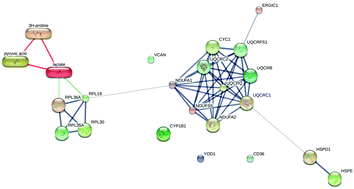NMR metabolomic and microarray-based transcriptomic data integration identifies unique molecular signatures of hypersensitivity pneumonitis†
Abstract
Hypersensitivity pneumonitis (HP) is an immune-mediated granulomatous interstitial lung disease (ILD) that results from repeated inhalation of certain antigens. Despite major advances in research, pathophysiology of the disease remains poorly understood. The present study combines metabolomic and transcriptomic data to determine alterations in HP subjects as compared with healthy controls. Metabolic signatures were identified in serum, exhaled breath condensate (EBC) and bronchoalveolar lavage fluid (BALF) of HP patients using proton nuclear magnetic resonance (NMR) metabolomics. The expression of three metabolites, i.e., lactate, pyruvate, and proline, was found to be significantly altered in all three biofluids. The potential of differential diagnosis based on these three metabolites was investigated by including a group of patients with sarcoidosis, which is another type of granulomatous ILD. In addition, differentially expressed transcriptomic fingerprints in blood samples were identified by analyzing a Gene Expression Omnibus (GEO) database. The transcriptomics analysis of these microarray-based data revealed 59 genes to be significantly dysregulated in patients with HP. Over representation analysis of the metabolites and genes of interest was performed using IMPaLA (Integrated Molecular Pathway Level Analysis) version 12. Integrated analysis of serum metabolite signatures and blood gene expression suggests dysregulation of PI3K–AKT signaling and TCA cycle pathways in these patients. This preliminary study is a step towards better understanding of the pathogenesis of HP by identification of differentially expressed metabolites and transcriptomic fingerprints. These molecular signatures may be explored as diagnostic markers for differentiating HP from other lung diseases.



 Please wait while we load your content...
Please wait while we load your content...